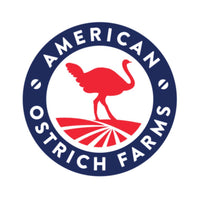Many pet owners are increasingly turning to raw feeding diets for their dogs, seeking to provide them with a more natural and nutritious diet. As they explore different protein sources, questions often arise about unconventional meats like ostrich. Is ostrich safe for dogs to eat? What are the benefits and risks? In this blog post, we'll delve into these questions and provide guidance on incorporating ostrich into your dog's diet safely.
IS OSTRICH SAFE FOR DOGS?
The short answer is yes, ostrich can be safe for dogs to eat. Ostrich meat is a lean protein source that is low in fat and rich in essential nutrients such as protein, iron, and B vitamins. When fed in moderation and as part of a balanced diet, ostrich can offer health benefits for your canine companion.
RAW FEEING AND OSTRICH
Many dog owners who opt for raw feeding diets may wonder if ostrich is a suitable option. The good news is that ostrich meat can indeed be included in a raw diet for dogs. When feeding raw ostrich, it's essential to handle it with the same precautions you would any other raw meat. This includes proper storage, hygiene, and sourcing from reputable suppliers to minimize the risk of contamination.
Additionally, while ostrich marrow bones and necks can be safe for dogs to chew on, it's crucial to supervise them during these activities. These larger bones can provide mental stimulation and help maintain dental health, but – as with any bones – there's always a risk of choking or splintering, especially with aggressive chewers. It's best to remove the bone once it becomes small enough to swallow to prevent any potential hazards. While ostrich marrow bones and necks are generally safe options for dogs, it's important to note that not all bones are created equal. Ostrich collagen bones, which are softer and more likely to splinter, should be avoided. These bones can pose a choking hazard or cause internal injuries if ingested. Always opt for larger, weight-bearing bones like marrow bones or necks when offering bones to your dog.
INCORPORATING OSTRICH INTO YOUR DOG'S DIET
If you're considering adding ostrich to your dog's diet, start slowly and observe how they react. Introduce small amounts of cooked or raw ostrich meat to see if your dog tolerates it well. Keep in mind that some dogs may have allergies or sensitivities to certain proteins, so monitoring for any adverse reactions is essential.
When feeding ostrich, ensure that it's part of a balanced diet that includes other protein sources, carbohydrates, healthy fats, and essential vitamins and minerals. Consult with your veterinarian or a canine nutritionist to develop a diet plan that meets your dog's specific nutritional needs.
Overall, ostrich can be a safe and nutritious addition to your dog's diet when fed responsibly. Whether you choose to incorporate it into a raw feeding regimen or offer it as a cooked protein source, remember to handle ostrich meat with care and supervise your dog during bone chewing activities. By taking these precautions and monitoring your dog's response, you can provide them with a varied and wholesome diet that supports their overall health and well-being.






